American alligator
| American alligator Temporal range: 8–0 Ma Miocene – Recent | |
|---|---|
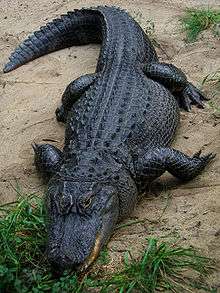 | |
| Scientific classification | |
| Kingdom: | Animalia |
| Phylum: | Chordata |
| Class: | Reptilia |
| Superorder: | Crocodylomorpha |
| Order: | Crocodilia |
| Family: | Alligatoridae |
| Genus: | Alligator |
| Species: | A. mississippiensis |
| Binomial name | |
| Alligator mississippiensis (Daudin, 1802 [originally Crocodilus]) | |
 | |
| Approximate range of American Alligator | |
| Synonyms | |
| |
The American alligator (Alligator mississippiensis), sometimes referred to colloquially as a gator or common alligator, is a large crocodilian reptile endemic to the southeastern United States. It is one of two living species in the genus Alligator within the family Alligatoridae; it is larger than the other extant alligator species, the Chinese alligator. Adult male American alligators measure 3.4 to 4.6 m (11 to 15 ft) in length, and can weigh up to 453 kg (1,000 lb). Females are smaller, measuring around 3 m (9.8 ft). The American alligator inhabits freshwater wetlands, such as marshes and cypress swamps from Texas to North Carolina. It is distinguished from the sympatric American crocodile by its broader snout, with overlapping jaws and darker coloration, and is less tolerant of saltwater but more tolerant of cooler climates than the American crocodile, which is found only in tropical climates.
Alligators are apex predators and consume fish, amphibians, reptiles, birds, and mammals. Hatchlings feed mostly on invertebrates. They play an important role as ecosystem engineers in wetland ecosystems through the creation of alligator holes, which provide both wet and dry habitats for other organisms. Throughout the year, but particularly during the breeding season, alligators bellow to declare territory and locate suitable mates.[2] Male alligators use infrasound to attract females. Eggs are laid in a nest of vegetation, sticks, leaves, and mud in a sheltered spot in or near the water. Young are born with yellow bands around their bodies and are protected by their mother for up to one year.[3]
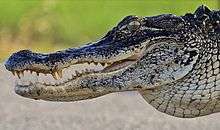
The American alligator is listed as Least Concern by the International Union for Conservation of Nature. Historically, hunting had decimated their population, and the American alligator was listed as an endangered species by the Endangered Species Act of 1973. Subsequent conservation efforts have allowed their numbers to increase and the species was removed from the list in 1987. Alligators are now harvested for their skins and meat. The species is the official state reptile of three states: Florida, Louisiana, and Mississippi.
Taxonomy and phylogeny
The American alligator was first classified by French zoologist François Marie Daudin as Crocodilus mississipiensis in 1801. In 1807 Georges Cuvier created the genus Alligator;[4] the American alligator shares this genus with the Chinese alligator. They are grouped in the family Alligatoridae with the caimans. The superfamily Alligatoroidea includes all crocodilians (fossil and extant) that are more closely related to the American alligator than to either the Nile crocodile or the gharial.[5]
Members of this superfamily first arose in the late Cretaceous. Leidyosuchus of Alberta is the earliest known genus. Fossil alligatoroids have been found throughout Eurasia as land bridges across both the North Atlantic and the Bering Strait have connected North America to Eurasia during the Cretaceous, Paleogene, and Neogene periods. Alligators and caimans split in North America during the late Cretaceous and the latter reached South America by the Paleogene, before the closure of the Isthmus of Panama during the Neogene period. The Chinese alligator likely descended from a lineage that crossed the Bering land bridge during the Neogene. The modern American alligator is well represented in the fossil record of the Pleistocene.[6] The alligator's full mitochondrial genome was sequenced in the 1990s and it suggests the animal evolved at a rate similar to mammals and greater than birds and most cold-blooded vertebrates.[7] However, the full genome, published in 2014, suggests that the alligator evolved much more slowly than mammals and birds.[8]
In 2016, a Miocene fossil alligator's skull was found at Marion County, Florida. Unlike the other extinct alligator species of in the same genus, the fossil skull was virtually indistinguishable from that of the modern American alligator. This alligator and the American alligator are now considered to be sister taxa, meaning that the Alligator mississippiensis lineage has existed in North America for over 8 million years.[9]
Characteristics
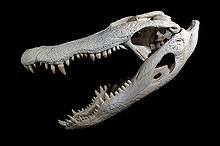
Domestic alligators vary from long and slender to short and robust, possibly due to variations in factors such as growth rate, diet, and climate. Alligators have broad snouts, especially in captive individuals. When the jaws are closed, the edges of the upper jaws cover the lower teeth which fit into the jaws' hollows. Like the spectacled caiman, this species has a bony nasal ridge, though it is less prominent.[10] The teeth number 74–80.[10] Dorsally, adult alligators may be olive, brown, gray, or black in color, while their undersides are cream-colored.[11]
Some alligators are missing an inhibited gene for melanin, which makes them albino. These alligators are extremely rare and almost impossible to find in the wild. They could only survive in captivity, as they are very vulnerable to the sun and predators.[12]
Size
The American alligator is a fairly large species of crocodilian. On average it is the second largest species in the Alligatoridae family, behind only the black caiman.[13] As with all crocodilians, and as opposed to many mammals where size eventually diminishes with old age, healthy alligators continue to expand throughout their lives and the oldest specimens are the largest. Very old, large male alligators reach an expected maximum size of up to 4.6 m (15 ft) in length, weighing up to 453 kg (1,000 lb), while females reach a maximum of 3 m (9.8 ft).[14][15] On rare occasions, a large, old male may grow to an even greater length.[16][17] During the 19th and 20th centuries, larger males reaching 5 to 6 m (16 to 20 ft) have been reported.[10] The largest reported individual size was a male killed in 1890 on Marsh Island, Louisiana, and reportedly measured at 5.8 m (19 ft) in length, but no voucher specimen was available, since the alligator was left on a muddy bank after having been measured due to having been too massive to relocate.[17] If the size of this animal were correct, it would have weighed approximately 1,000 kg (2,200 lb).[18] Large adult alligators tend to be relatively robust and bulky compared to other similarly length crocodilians, for example captive males measuring 3 to 4 m (9.8 to 13.1 ft) were found to weigh 200 to 350 kg (440 to 770 lb) (although captive specimens may outweigh wild specimens due to lack of hunting behavior and other stressors).[19][20] The largest alligator ever killed in Florida was 5.31 m (17.4 ft), as reported by the Everglades National Park.[21][22] The largest alligator scientifically verified in Florida for the period from 1977 to 1993 was reportedly 4.23 m (13.9 ft) and weighed 473 kg (1,043 lb), although another specimen (size estimated from skull) may have measured 4.54 m (14.9 ft).[19]
However, American alligators do not normally reach such extreme sizes. In mature males, most specimens grow up to about 3.4 m (11 ft) in length, and will weigh up to 227 kg (500 lb), while in females, the mature size is normally around 2.6 m (8.5 ft), with a body weight of up to 91 kg (201 lb).[23][24] In Newnans Lake, Florida, adult males averaged 73.2 kg (161 lb) in mass and measured 2.47 m (8.1 ft) in length while adult females averaged 55.1 kg (121 lb) and measured 2.22 m (7.3 ft).[25] In Lake Griffin State Park, Florida, adults weighed on average 57.9 kg (128 lb).[26] Weight at sexual maturity per one study was stated as averaging 30 kg (66 lb) while adult weight was claimed as 160 kg (350 lb).[27] While noticeably sexual dimorphic in size in very mature specimens, the sexual dimorphism of this species is relatively modest amongst crocodilians.[28] In the saltwater crocodile, for example, the females are only slightly larger at average (2.4 m (7.9 ft) in the alligator, 2.6 m (8.5 ft) in the crocodile) than female American alligators, but the mature males, at 4.3 to 5.2 m (14 to 17 ft) on average as opposed to 2.4 to 4 m (7.9 to 13.1 ft) expected in mature male alligators, are considerably bigger than male American alligators and at median are nearly twice as long as and at least four times as heavy as the female crocodiles of the same species.[29] Given that female alligators have relatively higher survival rates at an early age and a large percentage of given populations are comprised by immature or young breeding alligators, relatively few large mature males of the expected mature length of 3.4 m (11 ft) or more are typically seen.[30] Weight varies considerably depending on length, age, health, season and available food sources. Similar to many other reptiles than range expansively into temperate zones, American alligators from the northern end of their range, such as southern Arkansas, Alabama, and northern North Carolina, tend to reach smaller sizes. The largest alligator caught in Alabama was 4.5 m (15 ft) in length, weighing 459 kg (1,012 lb). [31] In Arkansas a man killed an alligator that was 4.04 m (13.3 ft) and 626 kg (1,380 lb).[32]
Physiology
When on land, an alligator moves either by sprawling or walking, the latter involving the reptile lifting its belly off the ground. The sprawling of alligators and other crocodilians is not similar to that of salamanders and lizards, being similar to walking. Therefore, the two forms of territorial locomotion can be termed the "low walk" and the "high walk". Unlike most other land vertebrates, alligators increase their speed through the distal rather than proximal ends of their limbs.[33] In the water, alligators swim like fish, moving their pelvic regions and tails from side to side.[34] American alligators held the record as having the strongest laboratory-measured bite of any living animal, measured at up to 9,452 newtons (2,125 lbf). It should be noted that this experiment had not been, at the time of the paper published, replicated in any other crocodilians, and the same laboratory was able to measure a greater bite force in saltwater crocodiles;[35][36] notwithstanding this very high biting force, the muscles opening the alligator's jaw are quite weak, and the jaws can be held closed by hand or tape when an alligator is captured. During respiration, air flow is unidirectional, looping through the lungs during inhalation and exhalation;[37] the alligator's abdominal muscles can alter the position of the lungs within the torso, thus shifting the center of buoyancy, which allows the alligator to dive, rise, and roll within the water.[38]
Distribution and habitat
%2C_EVER%2C_NPSPhoto%2C_SCotrell%2C_4-2011_(9255694189).jpg)
American alligators are found in the wild in the southeastern United States, from the Great Dismal Swamp in Virginia and North Carolina, south to Everglades National Park in Florida, and west to the southern tip of Texas. They are found in North Carolina, South Carolina, Georgia, Florida, Louisiana, Alabama, Mississippi, Arkansas, Oklahoma, and Texas. Some of these locations appear to be relatively recent introductions, with often small but reproductive populations.[39] They inhabit swamps, streams, rivers, ponds, and lakes. Females and juveniles are also found in Carolina Bays and other seasonal wetlands. While they prefer fresh water, alligators may sometimes wander into brackish water,[40] but are less tolerant of salt water than crocodiles, as the salt glands on their tongues do not function.[41] One study of alligators in north-central Florida found the males preferred open lake water during the spring, while females used both swampy and open water areas. During summer, males still preferred open water, while females remained in the swamps to construct their nests and lay their eggs. Both sexes may den underneath banks or clumps of trees during the winter.[25]
American alligators are less vulnerable to cold than American crocodiles. Unlike a crocodile, which would immediately succumb to the cold and drown in water of 45 °F (7 °C), an alligator can survive in such temperatures for some time without displaying any signs of discomfort.[42] This adaptiveness is thought to be the reason why American alligators are widespread further north than the American crocodile.[42] In fact, the American alligator is found farther from the equator and is more equipped to handle cooler conditions than any other crocodilian.[43] When the water begins to freeze, alligators stick their snouts through the surface which allows them to breathe above the ice.[40]
Ecology and behavior
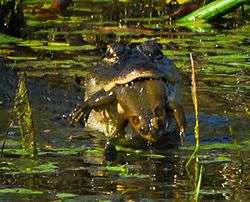
Alligators modify wetland habitats, most dramatically in flat areas such as the Everglades, by constructing small ponds known as alligator holes. This behavior has qualified the American alligator to be considered a keystone species. Alligator holes retain water during the dry season and provide a refuge for aquatic organisms. Aquatic organisms that survive the dry season by seeking refuge in alligator holes are a source of future populations. The construction of nests along the periphery of alligator holes, as well as a buildup of soils during the excavation process, provide drier areas for other reptiles to nest and a place for plants that are intolerant of inundation to colonize. Alligator holes are an oasis during the Everglades dry season, so are consequently important foraging sites for other organisms.[44] In the limestone depressions of cypress swamps, alligator holes tend to be large and deep, while those in marl prairies and rocky glades are usually small and shallow, and those in peat depressions of ridge and slough wetlands are more variable.[45]
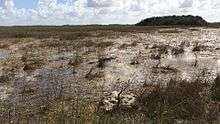
Alligators play an important role in the restoration of the Everglades as biological indicators of restoration success.[46] Alligators are highly sensitive to changes in the hydrology, salinity, and productivity of their ecosystems; all are factors that are expected to change with Everglades restoration. Alligators also may control the long-term vegetation dynamics in wetlands by reducing the population of small mammals, particularly coypu, which may otherwise overgraze marsh vegetation.[47] In this way, the vital ecological service they provide may be important in reducing rates of coastal wetland losses in Louisiana.[48] They may provide a protection service for water birds nesting on islands in freshwater wetlands. Alligators prevent predatory mammals from reaching island-based rookeries and in return eat spilled food and birds that fall from their nests. Wading birds appear to be attracted to areas with alligators and have been known to nest at heavily trafficked tourist attractions with large numbers of alligators, such as the St. Augustine Alligator Farm in St. Augustine, Florida.[49] In addition to basking on shore, American alligators can and will climb trees to bask in if no shoreline is available. However, this is not often seen as the alligators will retreat back into the water by jumping from their perch.[50]
Hunting and diet
The American alligator is considered an apex predator throughout its range. They are opportunists and their diet is determined largely by both the size and age of the alligator and the size and availability of prey. Most alligators will eat a wide variety of animals, including invertebrates, fish, birds, turtles, snakes, amphibians, and mammals. Hatchlings mostly feed on invertebrates such as insects, insect larvae, snails, spiders, and worms. As they grow, alligators gradually expand to larger prey. Once an alligator reaches adulthood, any animal living in the water or coming to the water to drink is potential prey, due to the size and power of the alligator. However, most animals captured by alligators are considerably smaller than the alligator itself.[10] Stomach contents show, among native mammals, muskrats and raccoons are some of the most commonly eaten species.[51] In Louisiana, where introduced coypu are common, they are perhaps the most regular prey for adult alligators, although only larger adult alligators commonly eat this species.[47][51] Other animals may occasionally be eaten, even large deer or feral wild boars, but these are not normally part of the diet. Occasionally, domestic animals, including dogs, cats, and calves, are taken as available, but are secondary to wild and feral prey.[10] Other prey, including snakes, lizards, and various invertebrates, are eaten occasionally by adults.[16] Water birds, such as herons and egrets, storks, waterfowl and large dabbling rails such as gallinules or coots, are taken when possible. Occasionally, unwary adult birds are grabbed and eaten by alligators, but most predation on bird species occur with unsteady fledgling birds in late summer as the prey of alligators, as fledgling birds attempt to make their first flights near the water's edge.[16]
The diet of adult alligators from central Florida lakes was dominated by fish, highly opportunistically based upon local availability. In Lake Griffin, fish made up 54% of the diet by weight, with catfish being most commonly consumed while in Lake Apopka, fish made up 90% of the food and mostly shad were taken and in Lake Woodruff the diet was 84% fish and largely consists of bass and sunfish. Unusually in this regions, reptiles and amphibians were the most important non-piscivore prey, mostly comprised by turtles and water snakes.[52] In southern Louisiana, crustacean (largely crayfish and crabs) were found to be present in the southeastern alligators but largely absent in the southwestern alligator which consumed a relatively high proportion of reptiles, although fish were the most recorded prey for adult alligators and adult males consumed a large portion of mammals.[53] In East Texas, diets were diverse and adult alligators took mammals, reptiles and amphibians and invertebrates (i.e. snails) in often equal measure as they did fish.[54]
Fish and other aquatic prey taken in the water or at the water's edge form the major part of alligator's diet and may be eaten at any time of the day or night. Adult alligators also spend considerable time hunting on land, up to 50 m (170 ft) from water, ambushing terrestrial animals on trailsides and road shoulders. Usually, terrestrial hunting occurs on nights with warm temperatures.[55] When hunting terrestrial prey, alligators may also ambush them from the edge of the water by grabbing them and pulling the prey into the water, the preferred method of predation of larger crocodiles.[16] The teeth of the alligator are designed to grip prey, but can not rip or chew flesh like teeth of some other predators (such as canids and felids). The alligator is capable of biting though a turtle's shell or a moderately sized mammal bone.[56]
Alligators will occasionally prey on large mammals, such as deer, but will usually do so when fish and smaller prey levels go down.[57] Rarely, alligators have been observed killing and eating bobcats, but such events are not common and have little effect on bobcat populations.[58][59] Alligator predation on Florida panthers is rare, but has been documented. Such incidents usually involve a panther trying to cross a waterway or coming down to a swamp or river to get a drink. The American alligator is the only known natural predator of the panther.[60] Alligator predation on black bears has also been recorded, although it is unknown if the bears taken were full grown adults.[61][62][63] Although alligators have been listed as predators of manatees, very little evidence exists of such predation.[64] In the 2000s, when invasive Burmese pythons occupied the Everglades, alligators have been recorded preying on them, possibly controlling populations, thus preventing the invasive species to spread up north.[65][66]
In 2013, alligators and other crocodilians were reported to also eat fruit.[67] Such behavior has been witnessed, as well as documented from stomach contents, with the alligators eating such fruit as wild grapes, elderberries, and citrus fruits directly from the trees. The discovery of this unexpected part of the alligator diet further reveals that alligators may be responsible for spreading seeds from the fruit it digests across its habitat.[68]
Tool use
American alligators have been documented using lures to hunt prey such as birds.[69] This means they are among the first reptiles recorded to use tools. By balancing sticks and branches on their heads, American alligators are able to lure birds looking for suitable nesting material to kill and consume. This strategy, which is shared by the mugger crocodile, is particularly effective during the nesting season, in which birds are more likely to gather appropriate nesting materials.[70]
Vocalizations
 |
|
| Problems playing these files? See media help. | |
Crocodilians are the most vocal of all reptiles and have a variety of different calls depending on the age, size, and sex of the animal.[71] The American alligator can perform specific vocalizations to declare territory, signal distress, threaten competitors, and locate suitable mates. Juvenile alligators can perform a high-pitched hatchling call (a "yelping" trait common to many crocodilian species' hatchling young)[72] to alert their mothers when they are ready to emerge from the nest. Juveniles also make a distress call to alert their mothers if they are being threatened. Although alligators have vocal cords, they function differently from those of mammals.[73] Both males and females bellow loudly to attract mates and declare territory by sucking air into their lungs and blowing it out in intermittent, deep-toned roars. The bellowing of the American alligator is distinct from the loud roaring of most crocodilians, and is considered unique. Male alligators are known to use infrasound during mating bellows. Bellowing is performed in a "head oblique, tail arched" posture. Infrasonic waves from a bellowing male alligator can cause the surface of the water directly over and to either side of its back to literally "sprinkle",[74] in what is commonly called the "water dance".[75] Large bellowing "choruses" of alligators during the breeding season are commonly initiated by females and perpetuated by males.[76] Observers of large bellowing choruses have noted they are often felt more than they are heard due to the intense infrasound emitted by males. Alligators bellow in B flat, and bellowing choruses can be induced by tuba players, sonic booms, and large aircraft.[77] In addition to bellowing, alligators can growl, hiss, or cough to threaten others and declare territory.
Reproduction
The breeding season begins in the spring. On spring nights, alligators gather in large numbers for group courtship, in the aforementioned "alligator dances".[78] The female builds a nest of vegetation, sticks, leaves, and mud in a sheltered spot in or near the water. After she lays her 20 to 50 white eggs, about the size of a goose egg, she covers them with more vegetation, which heats as it decays, helping to keep the eggs warm. This differs from Nile crocodiles, which lay their eggs in pits.[42]
The temperature at which alligator eggs develop determines their sex (see temperature-dependent sex determination). Those eggs which are hatched at a temperature of 34 °C (93 °F) or more become males, while those at a temperature of 30 °C (86 °F) or lower become female. The nests built on levees are warmer and thus produce males, while the cooler nests of wet marsh produce females.[79] The female remains near the nest throughout the 65-day incubation period, protecting it from intruders. When the young begin to hatch — their "yelping" calls can sometimes even be heard just before hatching commences — the mother quickly digs them out and carries them to the water in her mouth,[10] as some other crocodilian species are known to do.
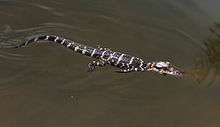
The young are tiny replicas of adult alligators with a series of yellow bands around their bodies that serve as camouflage.[10] Hatchlings gather into pods and are guarded by their mother and keep in contact with her through their "yelping" vocalizations. Young alligators eat small fish, frogs, crayfish, and insects.[80] They are preyed on by large fish, birds, raccoons, and adult alligators.[10] Mother alligators eventually become more aggressive towards their young, which encourages them to disperse.[80] Young alligators grow 3–8 in (7.6–20.3 cm) a year and reach adulthood at 6 ft (1.8 m).[40] An alligator can live up to 50 years.
Interactions with exotic species
Nutria were introduced into coastal marshes from South America in the mid-1900s, and their population has since exploded into the millions. They cause serious damage to coastal marshes and may dig burrows in levees. Hence, Louisiana has had a bounty to try to reduce nutria numbers. Large alligators, however, feed heavily on nutria, so alligators may not only control nutria populations in Louisiana, but also prevent them spreading east into the Everglades. Since hunting and trapping preferentially take the large alligators that are the most important in eating nutria, some changes in harvesting may be needed to capitalize on their ability to control nutria.[47]
Recently, a population of Burmese pythons became established in Everglades National Park. Substantial alligator populations in the Everglades may be a contributing factor in keeping the python populations low, preventing the spread of the species up north. While events of predation by Burmese pythons on young alligators have been observed, no evidence of a net negative effect has been seen on overall alligator populations.[81][82][83]
Conservation status
Historically, hunting and habitat loss have severely impacted alligator populations throughout their range, and whether the species would survive was in doubt. In 1967, the alligator was listed as an endangered species (under a law that was the precursor Endangered Species Act of 1973), since it was believed to be in danger of extinction throughout all or a significant portion of its range.[84]
Both the United States Fish and Wildlife Service (USFWS) and state wildlife agencies in the South contributed to the American alligator's recovery. Protection under the Endangered Species Act allowed the species to recuperate in many areas where it had been depleted. States began monitoring their alligator populations to ensure that they would continue to grow. In 1987, the USFWS removed the animal from the endangered species list, as it was considered to be fully recovered. The USFWS still regulates the legal trade in alligators and their products to protect still endangered crocodilians that may be passed off as alligators during trafficking.[84]
Relationships with humans
Attacks on humans
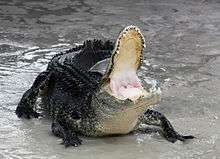
Alligators are capable of killing humans. Mistaken identity leading to an attack is always possible, especially in or near cloudy waters. Alligators are often less aggressive towards humans than larger crocodile species, a few of which (mainly the Nile and Saltwater crocodiles) may prey on humans with some regularity.[17][85] Alligator bites are serious injuries due to the reptile's sheer bite force and risk of infection. Even with medical treatment, an alligator bite may still result in a fatal infection.[86]
As human populations increase, and as they build houses in low-lying areas or fish or hunt near water, incidents are inevitable where alligators intrude, or at least appear to intrude, on human life. Since 1948, 257 documented attacks on humans in Florida (about five incidents per year) have been reported, of which an estimated 23 resulted in death.[87] Only nine fatal attacks occurred in the United States throughout the 1970s–1990s, but alligators killed 12 people between 2001 and 2007. In May 2006, alligators killed three Floridians in less than a week.[88] There have been at least 28 fatal attacks by alligators in the United States since 1970.
Alligator wrestling
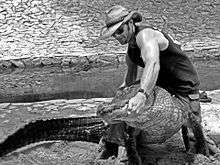
Since the late 1880s, alligator wrestling has been a source of entertainment for some. Created by the Miccosukee and Seminole tribes prior to the arrival of Europeans, this tourism tradition continues to persist despite criticism from animal rights activists.[89]
Alligator farming
Today, alligator farming is a large, growing industry in Georgia, Florida, Texas, and Louisiana. These states produce a combined annual total of some 45,000 alligator hides. Alligator hides bring good prices and hides in the 6 to 7-ft range have sold for $300 each.[90] The market for alligator meat is growing, and about 300,000 pounds (140,000 kg) of meat is produced annually.[91] According to the Florida Department of Agriculture and Consumer Services, raw alligator meat contains roughly 200 Calories (840 kJ) per 3-oz (85-g) serving, of which 27 Calories (130 kJ) come from fat.
Symbol
The American alligator is the official state reptile of Florida,[92] Louisiana,[93] and Mississippi.[94] Several organizations and products from Florida have been named after the animal.
"Gators" has been the nickname of the University of Florida's sports teams since 1911. In that year, a printer made a spur-of-the-moment decision to print an alligator emblem on a shipment of the school's football pennants. The mascot stuck, perhaps because the team captain's nickname was Gator.[95]
The Gator Bowl is a college football game held in Jacksonville annually since 1946, with Gator Bowl Stadium hosting the event until the 1993 edition. The Gatornationals is a NHRA drag race held at the Gainesville Raceway in Gainesville since 1970.
See also
- Alligator, a movie about a giant alligator living in the sewers of Chicago (despite the city being far beyond the American Alligator's range)
- Wally Gator, a cartoon about an anthropomorphic alligator
- The Alligator People
- Gatorland
- Brazos Bend State Park
- Sewer alligator
Notes
- ↑ Crocodile Specialist Group (1996). "Alligator mississippiensis". IUCN Red List of Threatened Species. Version 2008. International Union for Conservation of Nature. Retrieved February 24, 2009.
- ↑ Vilet, Kent (1989). "Social Displays of the American Alligator (Alligator mississippiensis)". American Zoology. 29 (3): 1019–1031. doi:10.1093/icb/29.3.1019.
- ↑ Pajerski, Lauren; Schechter, Benjamin; Street, Robin (2000). "Alligator mississippiensis". University of Michigan Museum of Zoology.
- ↑ Alligator Cuvier, 1807. ITIS.gov
- ↑ Brochu, Christopher A. (2003). "Phylogenetic approaches toward crocodylian history" (PDF). Annual Review of Earth and Planetary Sciences. 31: 357–97. doi:10.1146/annurev.earth.31.100901.141308.
- ↑ Brochu, Christopher A. (1999). "Phylogenetics, Taxonomy, and Historical Biogeography of Alligatoroidea". Society of Vertebrate Paleontology Memoir. 6: 9–100. doi:10.2307/3889340. JSTOR 3889340.
- ↑ Janke, A.; Arnason, U. (1997). "The complete mitochondrial genome of Alligator mississippiensis and the separation between recent archosauria (birds and crocodiles)". Molecular Biology and Evolution. 14 (12): 1266–72. doi:10.1093/oxfordjournals.molbev.a025736. PMID 9402737.
- ↑ Green RE, Braun EL, Armstrong J, Earl D, Nguyen N, Hickey G, Vandewege MW, St John JA, Capella-Gutiérrez S, Castoe TA, Kern C, Fujita MK, Opazo JC, Jurka J, Kojima KK, Caballero J, Hubley RM, Smit AF, Platt RN, Lavoie CA, Ramakodi MP, Finger JW, Suh A, Isberg SR, Miles L, Chong AY, Jaratlerdsiri W, Gongora J, Moran C, Iriarte A, McCormack J, Burgess SC, Edwards SV, Lyons E, Williams C, Breen M, Howard JT, Gresham CR, Peterson DG, Schmitz J, Pollock DD, Haussler D, Triplett EW, Zhang G, Irie N, Jarvis ED, Brochu CA, Schmidt CJ, McCarthy FM, Faircloth BC, Hoffmann FG, Glenn TC, Gabaldón T, Paten B, Ray DA (2014). "Three crocodilian genomes reveal ancestral patterns of evolution among archosaurs". Science. 346 (6215): 1254449. doi:10.1126/science.1254449. PMC 4386873
 . PMID 25504731.
. PMID 25504731. - ↑ Whiting, Evan T.; Steadman, David W.; Vliet, Kent A. (2016-06-01). "Cranial Polymorphism and Systematics of Miocene and Living Alligator in North America". Journal of Herpetology. 50 (2): 306–315. doi:10.1670/15-023. ISSN 0022-1511.
- 1 2 3 4 5 6 7 8 "Crocodilian Species—American Alligator (Alligator mississippiensis)". Flmnh.ufl.edu. Retrieved October 14, 2008.
- ↑ "American Alligator: Species Profile". US National Park Service. Retrieved August 14, 2012.
- ↑ "Zoo keeps albino alligator in the dark". NBC News.com. May 11, 2007. Retrieved August 15, 2012.
- ↑ Thorbjarnarson, J. B. (2010). Black caiman Melanosuchus niger. Crocodiles. Status Survey and Conservation Action Plan, 29–39.
- ↑ American Alligators, American Alligator Pictures, American Alligator Facts – National Geographic. Animals.nationalgeographic.com.
- ↑ American alligator Archived April 11, 2013, at the Wayback Machine.. Philadelphia Zoo.
- 1 2 3 4 Charles, S.; Ross, A. and Garnett, Stephen (1989) Crocodiles and Alligators. Checkmark Books. ISBN 978-0-8160-2174-1.
- 1 2 3 Wood, Gerald (1983). The Guinness Book of Animal Facts and Feats. ISBN 978-0-85112-235-9.
- ↑ Smith, E. N.; Standora, E. A. & Robertson, S. L. (1984). "Physiological thermoregulation of mature alligators". Comparative biochemistry and physiology. A, Comparative physiology. 77 (1): 189–93. PMID 6141029.
- 1 2 Woodward, A. R.; White, J. H. & Linda, S. B. (1995). "Maximum size of the alligator (Alligator mississippiensis)". Journal of Herpetology. 29 (4): 507–513. JSTOR 1564733.
- ↑ Clippinger, T. L.; Avery Bennett, R.; Johnson, C. M.; Vliet, K. A.; Deem, S. L.; Orós, J.; Brown, M. B. (2000). "Morbidity and mortality associated with a new mycoplasma species from captive American alligators (Alligator mississippiensis)". Journal of Zoo and Wildlife Medicine. 31 (3): 303–314. doi:10.1638/1042-7260(2000)031[0303:mamawa]2.0.co;2. PMID 11237136.
- ↑ Everglades National Park Flora & Fauna Page. Everglades National Park
- ↑ Florida alligator. Floridaadventuring.com (March 2, 2016). Retrieved on 2016-09-07.
- ↑ "Gator factsheet" (PDF). Savannah River Ecology Laboratory. Retrieved August 14, 2012.
- ↑ "American Alligator Fact Sheet". The National Zoo. Retrieved December 30, 2013.
- 1 2 Goodwin, Thomas M. (1979). "Seasonal activity ranges and habitat preferences of adult alligators in a north-central Florida lake". Journal of Hepatology. 13 (2): 157–64. doi:10.2307/1563922. JSTOR 1563922.
- ↑ Honeyfield, D. C.; Ross, J. P.; Carbonneau, D. A.; Terrell, S. P.; Woodward, A. R.; Schoeb, T. R.; Hinterkopf, J. P. (2008). "Pathology, physiologic parameters, tissue contaminants, and tissue thiamine in morbid and healthy central Florida adult American alligators (Alligator mississippiensis)". Journal of wildlife diseases. 44 (2): 280–294. doi:10.7589/0090-3558-44.2.280. PMID 18436661.
- ↑ Ruben, J. A.; Jones, T. D. (2000). "Selective factors associated with the origin of fur and feathers". American Zoologist. 40 (4): 585–596. doi:10.1668/0003-1569(2000)040[0585:sfawto]2.0.co;2.
- ↑ Saalfeld, D. T.; Webb, K. K.; Conway, W. C.; Calkins, G. E.; Duguay, J. P. (2008). "Growth and condition of American alligators (Alligator mississippiensis) in an inland wetland of east Texas". Southeastern Naturalist. 7 (3): 541–550. doi:10.1656/1528-7092-7.3.541.
- ↑ Webb, GJW.; Messel, H. (1978). "Morphometric analysis of Crocodylus porosus from the north coast of Arnhem Land, northern Australia". Australian Journal of Zoology. 26 (1): 1–27. doi:10.1071/zo9780001.
- ↑ Lance, V. A.; Elsey, R. M.; Lang, J. W. (2000). "Sex ratios of American alligators (Crocodylidae): male or female biased?". Journal of Zoology. 252 (1): 71–78. doi:10.1017/s0952836900009080.
- ↑ "Alabama alligator is largest ever legally killed in state". CBC News. Retrieved August 18, 2014.
- ↑ "Record gator caught in Southwest Arkansas". FoxNews.com. Retrieved March 15, 2014.
- ↑ Reilly, S. M.; Elias, J. A. (1998). "Locomotion in alligator mississippiensis: kinematic effects of speed and posture and their relevance to the sprawling-to-erect paradigm" (PDF). The Journal of Experimental Biology. 201 (18): 2559–74. PMID 9716509.
- ↑ Fish, F. E. (1984). "Kinematics of undulatory swimming in the American alligator" (PDF). Copeia. 1984 (4): 839–43. doi:10.2307/1445326. JSTOR 1445326.
- ↑ Erickson, Gregory M.; Lappin, A. Kristopher; Vliet, Kent A. (2003). "The ontogeny of bite-force performance in American alligator (Alligator mississippiensis)" (PDF). Journal of Zoology. 260 (3): 317–327. doi:10.1017/S0952836903003819.
- ↑ Australian saltwater crocodiles are world's most powerful biters. Science Daily (March 16, 2012)
- ↑ Farmer, C. G.; Sanders, K. (2010). "Unidirectional airflow in the lungs of alligators". Science. 327 (5963): 338–340. doi:10.1126/science.1180219. PMID 20075253.
- ↑ Uriona, T. J.; Farmer, C. G. (2008). "Recruitment of the diaphragmaticus, ischiopubis and other respiratory muscles to control pitch and roll in the American alligator (Alligator mississippiensis)". Journal of Experimental Biology. 211 (7): 1141–11477. doi:10.1242/jeb.015339. PMID 18344489.
- ↑ "NAS - Nonindigenous Aquatic Species: Alligator mississippiensis". USGS.
- 1 2 3 "American Alligator (Alligator mississippiensis)". Savannah River Ecology Laboratory. Retrieved August 16, 2012.
- ↑ "What's the difference between a crocodile and an alligator?". Flmnh.ufl.edu. Retrieved August 26, 2012.
- 1 2 3 Guggisberg, C.A.W. (1972). Crocodiles: Their Natural History, Folklore, and Conservation. Newton Abbot: David & Charles. p. 195. ISBN 0-7153-5272-5.
- ↑ Lance, Valentine A. (2003). "Alligator physiology and life history: the importance of temperature". Experimental Gerontology. 38 (7): 801–805. doi:10.1016/S0531-5565(03)00112-8. PMID 12855291.
- ↑ Rice, Ken G.; Mazzotti, Frank (October 2005). "American Alligator Ecology and Monitoring for the Comprehensive Everglades Restoration Plan" (PDF). University of Florida IFAS Extension.
- ↑ Campell, Mark R.; Mazzotti, Frank J. (2004). "Characterization of Natural and Artificial Alligator Holes" (PDF). Southeastern Naturalist. 3 (4): 583–94. doi:10.1656/1528-7092(2004)003[0583:CONAAA]2.0.CO;2.
- ↑ Harvey, Rebecca G.; Brandt, Laura A.; Mazzotti, Frank J. (October 2011). "The American Alligator: An Indicator Species for Everglades Restoration" (PDF). University of Florida IFAS Extension.
- 1 2 3 Keddy, P.A., L. Gough, J.A. Nyman, T. McFalls, J. Carter and J. Siegrist (2009). Alligator hunters, pelt traders, and runaway consumption of Gulf coast marshes: A trophic cascade perspective on coastal wetland losses. pp. 115–133 in B.R. Silliman, E.D. Grosholz, and M.D. Bertness (eds.) Human Impacts on Salt Marshes. A Global Perspective. University of California Press, Berkeley, CA ISBN 0-520-25892-4 Google Books
- ↑ Keddy, P.A. (2010). Wetland Ecology: Principles and Conservation (2nd edition). Cambridge University Press, Cambridge, UK. ISBN 0-521-78367-4.
- ↑ White, C.; Frederick, P.; Main, M.; Rodgers, J. (May 2005). "Nesting Island Creation for Wading Birds" (PDF). University of Florida IFAS Extension.
- ↑ Dinets, Vladimir; Britton, Adam; Shirley, Matthew (2013). "Climbing behaviour in extant crocodilians" (PDF). Herpetology Notes. 7: 3–7. (published online January 25, 2014)
- 1 2 Valentine Jr, J. M.; Walther, J. R.; McCartney, K. M.; Ivy, L. M. (1972). "Alligator diets on the Sabine National Wildlife Refuge, Louisiana". The Journal of Wildlife Management. 36 (3): 809–815. doi:10.2307/3799434. JSTOR 3799434.
- ↑ Rice, A. N. (2004). Diet and condition of American alligators (Alligator mississippiensis) in three central Florida lakes (Doctoral dissertation, University of Florida).
- ↑ Gabrey, S. W. (2010). "Demographic and geographic variation in food habits of American alligators (Alligator mississippiensis) in Louisiana" (PDF). Herpetological Conservation and Biology. 5 (2): 241–250.
- ↑ Saalfeld, D. T.; Conway, W. C.; Calkins, G. E. (2011). "Food Habits of American Alligators (Alligator mississippiensis) in East Texas". Southeastern Naturalist. 10 (4): 659–672. doi:10.1656/058.010.0406.
- ↑ Dinets, V. L. (2011). "On terrestrial hunting in crocodilians" (PDF). Herpetological Bulletin. 114: 15–18.
- ↑ WEC203/UW230: Living with Alligators: A Florida Reality. Edis.ifas.ufl.edu. Retrieved on August 21, 2012.
- ↑ "American Alligator". News Daily.
- ↑ "Gator eats bobcat". Flickr. Retrieved November 7, 2012.
- ↑ "Sneaky alligator nearly eats bobcat". Kens5. Retrieved June 1, 2012.
- ↑ Sivlerstein, Alvin (1997). The Florida Panther. Brooksville, Connecticut: Millbrook Press. pp. 41+. ISBN 0-7613-0049-X.
- ↑ "American Alligator". Animal List.
- ↑ "Alligators". Aquatic Community.
- ↑ "Key West Florida Attractions | Alligator Exhibit". Key West Aquarium. Retrieved December 20, 2012.
- ↑ Whitaker, John O. (1996). The Audubon Society Field Guide to North American Mammals. New York, pg. 808. ISBN 978-0-679-44631-6.
- ↑ Dorcas, M. E.; Willson, J. D.; Reed, R. N.; Snow, R. W.; Rochford, M. R.; Miller, M. A.; Hart, K. M. (2012). "Severe mammal declines coincide with proliferation of invasive Burmese pythons in Everglades National Park". Proceedings of the National Academy of Sciences. 109 (7): 2418–2422. doi:10.1073/pnas.1115226109.
- ↑ Nolen, R. S. (2012). "How big is Florida's python problem?". J Am Vet Med Assoc. 240 (7): 778–782. doi:10.2460/javma.240.7.778. PMID 22443430.
- ↑ Choi, Charles Q. (August 30, 2013). "Crocodiles and alligators like to chomp down on ... fruit !". NBC News: Science. Retrieved August 31, 2013.
- ↑ Platt, S.G; Elsey, R.M; Liu, H. (2013). "Frugivory and seed dispersal by crocodilians: an overlooked form of saurochory?". Journal of Zoology. 291: n/a. doi:10.1111/jzo.12052.
- ↑ Dinets, V; Brueggen, JC; Brueggen, J.D. (2013). "Crocodilians use tools for hunting". Ethology, Ecology and Evolution. 1: 74–78. doi:10.1080/03949370.2013.858276.
- ↑ "Crocodiles are cleverer than previously thought: Some crocodiles use lures to hunt their prey". ScienceDaily. December 4, 2013. Retrieved December 8, 2013.
- ↑ Britton, Adam. "Crocodile Talk". University of Bristol and Florida Museum of Natural History.
- ↑ "Yelping" of alligator hatchlings. YouTube.com (September 3, 2013). Retrieved on 2016-09-07.
- ↑ Riede, T; Tokuda, I. T.; Farmer, C. G. (2011). "Subglottal pressure and fundamental frequency control in contact calls of juvenile Alligator mississippiensis". Journal of Experimental Biology. University of Utah. 214 (Pt 18): 3082–95. doi:10.1242/jeb.051110. PMC 3160820
 . PMID 21865521.
. PMID 21865521. - ↑ Male alligator "sprinkling" while bellowing in near-infrasound during courtship. YouTube.com (April 28, 2010). Retrieved on 2016-09-07.
- ↑ Garrick, L. D.; Lang, J. W. (1977). "Social Displays of the American Alligator". American Zoologist. 17: 225–239. doi:10.1093/icb/17.1.225.
- ↑ Garrick, L.; Lang, J.; Herzog, H. (1978). "Social Signals of Adult American Alligators". 60 (3): 153–192.
- ↑ Kilnkenberg, Jeff (June 21, 2013). "Alligators in B Flat? Gatorland's denizens roar in ecstasy". Tampa Bay Times.
- ↑ Dinets, V. L. (2010). "Nocturnal behavior of the American Alligator (Alligator mississippiensis) in the wild during the mating season". Herpetological Bulletin. 111: 4–11.
- ↑ Joanen, T.; Ferguson, M. W. J. (1982). "Temperature of egg incubation determines sex in Alligator mississippiensis". Nature. 296 (5860): 850–53. doi:10.1038/296850a0. PMID 7070524.
- 1 2 Hunt, R. H; Watanabe, M. E. (1982). "Observations on the maternal behavior of the American alligator, Alligator mississippiensis". Journal of Herpetology. 16 (3): 235–39. doi:10.2307/1563716. JSTOR 1563716.
- ↑ Gator-guzzling python comes to messy end. Associated Press (October 5, 2005). Retrieved 2008-03-11.
- ↑ Butler, Rhett A. (October 5, 2005) Python explodes after swallowing 6-foot alligator in Florida Everglades. Mongabay.com. Retrieved 2008-03-11.
- ↑ United States Department of the Interior, U.S. Geological Survey (February 20, 2008). USGS Maps Show Potential Non-Native Python Habitat Along Three U.S. Coasts. www.usgs.gov. Retrieved 2008-03-11.
- 1 2 "American Alligator Alligator mississippiensis" (PDF). U.S. Fish and Wildlife Service. February 2008. Retrieved September 3, 2012.
- ↑ Crocodile and Alligator Differences – Animal Facts for Kids. Sciencekids.co.nz (July 11, 2012). Retrieved on 2012-08-21.
- ↑ Harding, Brett E.; Wolf, Barbara C. (2006). "Alligator Attacks in Southwest Florida". Journal of Forensic Sciences. 51 (3): 674–677. doi:10.1111/j.1556-4029.2006.00135.x. PMID 16696720.
- ↑ McLaughlin, Eliott C.; Almasy, Steve and Shoichet, Catherine E. (2016-06-16) Disney alligator attack: Resort to add warning signs, source says. CNN
- ↑ "A String of Deaths by Gators in Florida". nytimes.com. May 15, 2006. Retrieved May 15, 2006.
- ↑ "Alligator wrestling – cruelty or tradition?". BBC News.com. March 17, 2009. Retrieved August 29, 2012.
- ↑ Lane, Thomas J.; Ruppert, Kathleen C. (June 2008). "Alternative Opportunities for Small Farms:Alligator Production Review" (PDF). University of Florida. Retrieved August 29, 2012.
- ↑ Reig Eimeric (2006). "Gator Maters: Florida farmers find lucrative business mating alligators". Orange and Blue Magazine. Retrieved August 29, 2012.
- ↑ "Alligator". Florida State Symbols. Florida Division of Historical Resources. 2013. Retrieved April 6, 2013.
- ↑ "About Louisiana". Louisiana.gov. State of Louisiana. Retrieved April 6, 2013.
- ↑ Act No. 302 of July 1, 2005. Retrieved on April 6, 2013.
- ↑ "History: 1906–1927, early Gainesville". University of Florida. Archived from the original on December 31, 2010. Retrieved February 13, 2011.
External links
| Wikimedia Commons has media related to: |
| Wikispecies has information related to: Alligator mississippiensis |
- Crocodilian Online
- Photo exhibit on alligators in Florida from State Archives of Florida
- Why the Gulf Coast needs more big alligators
- Alligator bellows and hisses – sound clips from the U.S. Fish and Wildlife Service
- View the allMis1 genome assembly in the UCSC Genome Browser.

_while_breathing_-_pone.0004497.s009.ogv.jpg)